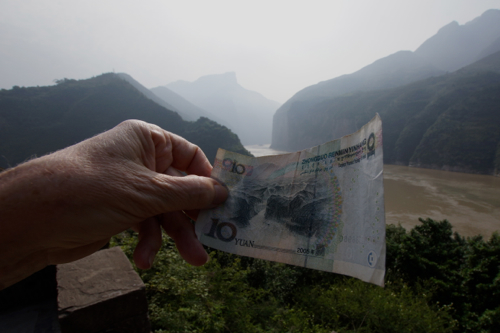One hours flight from the calm of Guilin is the mega city of Chongqing, the starting point of our Yangtze Cruise.
Built on the banks of the Yangtze this regional capital is home to 34 million people.
It’s one of the fastest growing cities in China.
We were met at the airport by our new guide, Chris, and soon found ourselves in the midst of the Mid Autumn Festival celebrations, in Ciqikou, the old town area of Chongqing.
This area was a labyrinth of crowded, winding streets, full of vendors selling everything from grilled octopus on sticks to fortune telling on cards.
In the afternoon we visited the Three Gorges Museum. It’s dedicated to showcasing the history and culture of the local area. A history that goes back over two million years.
There is also a degree of political spin that justifies the building of the controversial Three Gorges Dam.
It was then down to the quay to board the Century Legend for our three day cruise of the Yangtze River.
As we slowly sailed north the scenery alternated between rural and urban. One constant was the development – China is very much a work in progress.
Late in the afternoon of our first day we ventured off the ship and visited the Shibaozhai Pagoda. The base of the pagoda was originally constructed in the Ming Dynasty (1364-1644) while the top tiers were built in 1956.
The Shibaozhai Pagoda has suffered from the rising Yangtze waters and now has a huge levee bank to stop it being reclaimed by the river.
The next day we had an early start, to visit the White Emperor City. It was originally built on a peninsula, now that peninsula is an island.
Another victim of the the Three Gorges Dam.
White Emperor City is also known as the City of Poems, as there are over 70 poems, carvings and cultural relics of the Sui, Yuan, Ming and Qing Dynasties at the site. So important is this part of the Yangtze that the view from the temple is featured on the Ten Yuan note.
Later we started to move through the first two of the three gorges, Qutang and Wu. The air was still hazy, a combination of smoke and fog.
Qutang is the shortest and regarded as the most spectacular of the three. Measuring only eight kilometers in length and 150 meters wide at its narrowest point, with mountains rising to 1,200 meters on either side.
The Wu Gorge, sometimes called the Great Gorge is formed by the Wu River and is 45 kilometers in length.
Late in the day we made a side trip up the Shennong Stream and it was here that I had a major camera malfunction. Both my 70-300mm and 18-55mm lenses stopped working.
Oh no, not déjà vu again.
A similar thing happened to me last year in Japan and I was forced to buy a new camera. It looked like I was up for more distressed purchases.
Our last night on board was a celebration of the Mid Autumn Festival and we were given a Chinese banquet with more strange cuts of meat. Cuts that, if we were home, would have be relegated to the abattoir floor.
Whatever we were served it was very tasty.
The highlight of the night was passing through the five locks of the Three Gorges Dam. It was excruciatingly slow, taking 3.5 hours to descend the 100 meters from the reservoir to the Yangtze River below.
Our final morning was another early start, as we were to make a trip to the dam wall.
The fog had closed in, which isn’t surprising considering that his area has at least 100 foggy days per year.
As we were due to fly to Hangzhou, early in the afternoon, we had to miss the Xiling Gorge, the last of the three. The Xiling was once regarded as the most dangerous, with whirlpools and strong rapids. However since the building of the dam the water level in some areas below the dam has increased from 3 meters to over 100 meters. This is the largest of the Three Gorges, taking up nearly half the length of the entire Three Gorges region.
The airport at Yichang is the smallest in China, and the quietest. We arrived far too early and had to wait for hours for our flight.
We could have seen the Xiling Gorge after all, that’s of course if it had been visible through the smog.











Bruce, it was great re-living the Yangtse experience through your commentary. But, oh no, not again – I couldn’t believe your news about camera troubles.
Cheers, Alex.